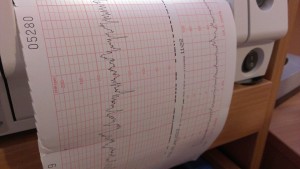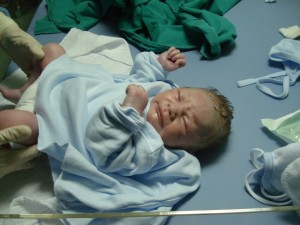If you are wondering why we have been posting lots of stuff about pregnancy….well…. we love for kids to have the best chance in the world….AND because we are about to become grandparents in December!
10 procedures to think twice about during your pregnancy
 Despite a healthcare system that outspends those in the rest of the world, infants and mothers fare worse in the U.S. than in many other industrialized nations. Infants in this country are more than twice as likely to die before their first birthday as those in Japan and Finland. And America now ranks behind 59 other countries in preventing mothers from dying during childbirth and is one of only eight countries in the world, along with Afghanistan and El Salvador, whose maternal mortality rate is rising.
Despite a healthcare system that outspends those in the rest of the world, infants and mothers fare worse in the U.S. than in many other industrialized nations. Infants in this country are more than twice as likely to die before their first birthday as those in Japan and Finland. And America now ranks behind 59 other countries in preventing mothers from dying during childbirth and is one of only eight countries in the world, along with Afghanistan and El Salvador, whose maternal mortality rate is rising.Why?
Partly because mothers in the U.S. tend to be less healthy than in the past, “which contributes to a higher-risk pregnancy,” says Diane Ashton, M.D., deputy medical director of the March of Dimes.
But another key reason may be that medical expediency appears to be taking a priority over the best outcomes. The U.S. healthcare system has developed into a labor-and-delivery machine, often operating according to its own timetable rather than the less predictable schedule of mothers and babies. Keeping things chugging along are technological interventions that can be lifesaving in some situations but also interfere with healthy, natural processes and increase risk when used inappropriately.
One example: The nation’s continued high C-section rates. Nearly one of every three American babies enters this world through a surgical birth. But when C-sections aren’t medically indicated, they may be more likely to harm mothers and babies than to help them.
Aaron B. Caughey, M.D., chair of the Department of Obstetrics and Gynecology at Oregon Health & Science University School of Medicine in Portland, points out that as the rate of cesareans in the country increased over the past several decades, the country did not see fewer deaths among newborns. “In fact, if anything, we started to see an increase in maternal mortality,” he says.
ACOG also partnered with the American Academy of Family Physicians (AAFP), as part of a campaign called Choosing Wisely, to publicly warn against the overuse of two other common interventions in pregnancy: planned early deliveries and inducing labor without a strong medical reason.
These outcomes are far worse for African American infants and mothers than they are for non-Hispanic whites: African-American infants are more than twice as likely to die than white babies and African-American mothers are three to four times more likely to perish from pregnancy-related complications than white mothers.
The idea, of course, is not to reject all interventions. The course of childbirth is not something that anyone can completely control. In some situations, inducing labor or doing a C-section is the safest option. And complications are the exception, not the norm.
But when they’re not medically necessary, research shows that the interventions listed below are associated with poorer outcomes for mothers, babies, or both.
1. A C-Section With a Low-Risk First Birth
While C-sections generally pose few risks, “the safest method for both mom and baby is an uncomplicated vaginal birth,” says Catherine Spong, M.D., chief of the pregnancy and perinatology branch at the Eunice Kennedy Shriver National Institute of Child Health and Human Development.
The best way to reduce the number of C-sections overall is to decrease the number of them among low-risk women who are delivering their first child. That’s because having an initial C-section “sets the stage for a woman’s entire reproductive life,” says Elliott Main, M.D., medical director of the California Maternal Quality Care Collaborative, a program to reduce unnecessary C-sections in that state. “In this country, if your first birth is a C-section, there’s a 90 percent chance all subsequent births will be as well,” he says.
A C-section is major surgery. So it’s no surprise that as rates for the procedure go down, so do the numbers for several complications, especially infection or pain at the site of the incision. A C-section can also complicate future pregnancies, increasing the risk of problems with the placenta, ectopic pregnancies (those that occur outside the uterus), or a rupture of the uterine scar. And the risks increase with each additional cesarean birth.
In some situations, such as when the mother is bleeding heavily or the baby’s oxygen supply is compromised, surgical delivery is absolutely necessary. But women can maximize their chances of avoiding an unnecessary cesarean by finding a caregiver and birthing environment that supports vaginal birth. When choosing a practitioner and hospital or birth center, ask about its C-section rates, particularly rates for low-risk deliveries. Use our hospital Ratings to find cesarean rates of hospitals near you. And read more about how to avoid unnecessary C-sections.
2. An Automatic Second C-Section
 Just because your first baby was delivered by cesarean doesn’t mean your second has to be, too. In fact, many women who have had a prior C-section are good candidates for a vaginal birth after cesarean (VBAC), according to ACOG.
Just because your first baby was delivered by cesarean doesn’t mean your second has to be, too. In fact, many women who have had a prior C-section are good candidates for a vaginal birth after cesarean (VBAC), according to ACOG.Yet the percentage of VBACs has declined sharply since the mid-1990s, particularly after ACOG said in 1999 that they should be considered only if hospitals had staff “immediately available” to do emergency C-sections if necessary. And some obstetricians don’t do VBACs because they lack hospital support or training, or because their malpractice insurance won’t provide coverage. So women seeking a VBAC delivery might have trouble finding a supportive practitioner and hospital. “It’s tragic, really,” Main says. “In many parts of the country, the option has all but disappeared.”
Instead, if you have had a C-section, find out whether your obstetrician and hospital are willing to try a VBAC. Let them know that you understand that your baby will be monitored continuously during labor, and ask what the hospital would do if an emergency C-section became necessary.
3. An Elective Early Delivery
 Of course, some babies arrive sooner than expected and complications during pregnancy, such as skyrocketing blood pressure in the mother, can make early delivery the safest option. But hastening the birth of an otherwise healthy baby—even by a couple of days—is never a good idea.
Of course, some babies arrive sooner than expected and complications during pregnancy, such as skyrocketing blood pressure in the mother, can make early delivery the safest option. But hastening the birth of an otherwise healthy baby—even by a couple of days—is never a good idea.“Important fetal development takes place to your baby’s brain and lungs during those last few weeks of pregnancy,” says Leah Binder, president and CEO of the Leapfrog Group, a nonprofit organization that advocates for improved quality and safety in the U.S. healthcare system. Babies born at full-term, which is at least 39 weeks, have lower rates of breathing problems and are less likely to need neonatal intensive care.
Perhaps because late preterm infants have more problems, mothers are more likely to suffer from postpartum depression. In addition, the procedures required to intentionally deliver a baby early—either an induced labor or a C-section—also carry a higher risk of complications than a full-term vaginal delivery.
Yet rates of these scheduled births skyrocketed in the early 2000s, to the point that almost 17 percent of births were scheduled before 39 weeks. In response, ACOG and a number of other groups—including the American Academy of Pediatrics, the American College of Nurse Midwives, the American Hospital Association, and the March of Dimes—initiated a campaign to sharply reduce early elective deliveries.
The effort was spectacularly successful: Rates dropped to 4.6 in 2013, making it “one of the most extraordinary examples of progress in healthcare that I’ve seen in my career,” Binder says.
4. Inducing Labor Without a Medical Reason
 Even after 39 weeks of pregnancy, you should resist the urge to induce labor unless there is a strong medical reason, says Debra Bingham, R.N., vice president of the Association of Women’s Health, Obstetric and Neonatal Nurses. She points out that women who go into labor naturally can usually spend the early portion at home, moving around as they feel most comfortable. An induced labor takes place in a hospital, where a woman will be hooked up to at least one intravenous line and an electronic fetal monitor. In addition, most hospitals don’t allow eating or drinking once induction begins.
Even after 39 weeks of pregnancy, you should resist the urge to induce labor unless there is a strong medical reason, says Debra Bingham, R.N., vice president of the Association of Women’s Health, Obstetric and Neonatal Nurses. She points out that women who go into labor naturally can usually spend the early portion at home, moving around as they feel most comfortable. An induced labor takes place in a hospital, where a woman will be hooked up to at least one intravenous line and an electronic fetal monitor. In addition, most hospitals don’t allow eating or drinking once induction begins.“An induced labor may occur prior to a woman’s body or baby being ready,” Bingham says. “This means labor may take longer and that the woman is two to three times more likely to give birth surgically.” Induced labor frequently leads to further interventions—including epidurals for pain relief, deliveries with the use of forceps or vacuums, and C-sections—that carry risks of their own.
For example, a 2011 study found that women who had labor induced without a recognized indication were 67 percent more likely to have a C-section, and their babies were 64 percent more likely to wind up in a neonatal intensive care unit, compared with women allowed to go into labor on their own.
Induction is justified when there’s a medical reason, such as when a woman’s membranes rupture, or her “water breaks,” and labor doesn’t start, or when she’s a week or more past her due date.
5. Ultrasounds After 24 Weeks
 Unless there is a specific condition your provider is tracking, you usually don’t need an ultrasound after 24 weeks. Although some practitioners use ultrasounds after this point to estimate fetal size or due date, the margin of error increases as the pregnancy progresses. And the procedure doesn’t provide any additional information leading to better outcomes for either mother or baby, according to a 2009 review of eight trials involving 27,024 women. In fact, the practice was linked to a slightly higher C-section rate.
Unless there is a specific condition your provider is tracking, you usually don’t need an ultrasound after 24 weeks. Although some practitioners use ultrasounds after this point to estimate fetal size or due date, the margin of error increases as the pregnancy progresses. And the procedure doesn’t provide any additional information leading to better outcomes for either mother or baby, according to a 2009 review of eight trials involving 27,024 women. In fact, the practice was linked to a slightly higher C-section rate.6. Continuous Electronic Fetal Monitoring
 Continuous monitoring, during which you’re hooked up to a monitor to record your baby’s heartbeat throughout labor, restricts your movement and increases the chance of a cesarean or delivery with forceps. In addition, it doesn’t reduce the risk of cerebral palsy or death for the baby, research suggests. The alternative is to monitor the baby at regular intervals using an electronic fetal monitor or a handheld ultrasound device. Continuous electronic monitoring is recommended if you’re given oxytocin to strengthen labor, you’ve had an epidural, or you’re attempting a VBAC.
Continuous monitoring, during which you’re hooked up to a monitor to record your baby’s heartbeat throughout labor, restricts your movement and increases the chance of a cesarean or delivery with forceps. In addition, it doesn’t reduce the risk of cerebral palsy or death for the baby, research suggests. The alternative is to monitor the baby at regular intervals using an electronic fetal monitor or a handheld ultrasound device. Continuous electronic monitoring is recommended if you’re given oxytocin to strengthen labor, you’ve had an epidural, or you’re attempting a VBAC.7. Early Epidurals
An epidural places anesthesia directly into the spinal canal, so that you remain awake but don’t feel pain below the administration point. But the longer an epidural is in place, the more medication accumulates and the less likely you will be able to feel to push. Epidurals can also slow labor. By delaying administration and using effective labor support strategies, you might be able to get past a tough spot and progress to the point you no longer feel it’s needed. If you do have an epidural, ask the anesthesiologist about a lighter block. “Ideally, a woman should still be able to move her legs and lift her buttocks,” Main says.
8. Routine Rupture of Membranes
Doctors sometimes rupture the amniotic membranes or “break the waters,” supposedly to strengthen contractions and shorten labor. But the practice doesn’t have that effect and may increase the risk of C-sections, according to a 2009 review of 15 trials involving 5,583 women. In addition, artificially rupturing amniotic membranes can cause rare but serious complications, including problems with the umbilical cord or the baby’s heart rate.
9. Routine Episiotomies
Practitioners sometimes make a surgical cut just before delivery to enlarge the opening of the vagina. That can be necessary in the case of a delivery that requires help from forceps or a vacuum, or if the baby is descending too quickly for the tissues to stretch. But in other cases, routine episiotomies don’t help and are associated with several significant problems, including more damage to the perineal area (area near the rectum) and a longer healing period, according to a 2009 review involving more than 5,000 women.
10. Sending Newborns to the Nursery
 If your baby has a problem that needs special monitoring, then sending him or her to a nursery or even an intensive care unit is essential. But in other cases, allowing healthy infants and mothers to stay together promotes bonding and breastfeeding. Moms get just as much sleep, research shows, and they learn to respond to the feeding cues of their babies. Allowing mothers and babies to stay together is one of the criteria hospitals must meet to be certified as “baby friendly” by the Baby-Friendly Hospital Initiative, a program sponsored by the World Health Organization (WHO) and the United Nations Children’s Fund (UNICEF).
If your baby has a problem that needs special monitoring, then sending him or her to a nursery or even an intensive care unit is essential. But in other cases, allowing healthy infants and mothers to stay together promotes bonding and breastfeeding. Moms get just as much sleep, research shows, and they learn to respond to the feeding cues of their babies. Allowing mothers and babies to stay together is one of the criteria hospitals must meet to be certified as “baby friendly” by the Baby-Friendly Hospital Initiative, a program sponsored by the World Health Organization (WHO) and the United Nations Children’s Fund (UNICEF).This article first appeared by Consumer Reports
